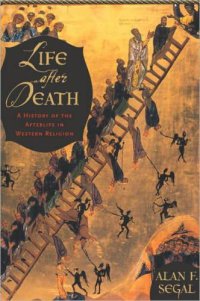
Ebook: Life after death: a history of the afterlife in the religions of the West
Author: Segal Alan F
- Tags: BODY MIND & SPIRIT--Gaia & Earth Energies, Eschatologie, Godsdiensten, Islam, Jenseitsglaube, Judentum, Leven na de dood, Religion, RELIGION--Christianity--General, RELIGION--Theology, Vie future, Future life, Electronic books, Neues Testament, BODY MIND & SPIRIT -- Gaia & Earth Energies, RELIGION -- Christianity -- General, RELIGION -- Theology, Alter Orient, Griechenland (Altertum)
- Year: 2004
- Publisher: The Doubleday Religious Publishing Group
- City: New York;Alter Orient;Griechenland (Altertum
- Edition: 1st ed
- Language: English
- mobi
Introduction : The undiscover'd country -- pt. 1. The climate of immortality. Egypt -- Mesopotamia and Canaan -- The First Temple Period in Israel -- pt. 2. From climate to the self. Iranian views of the afterlife and ascent to the heavens -- Greek and classical views of life after death and ascent to the heavens -- Second Temple Judaism : the rise of a beatific afterlife in the Bible -- pt. 3. Visions of resurrection and the immortality of the soul. Apocalypticism and millenarianism : the social backgrounds to the martyrdoms in Daniel and Qumran -- Religiously interpreted states of consciousness : prophecy, self-consciousness, and life after death -- Sectarian life in New Testament times -- pt. 4. The path to modern views of the afterlife. Paul's vision of the afterlife -- The Gospels in contrast to Paul's writings -- The pseudepigraphic literature -- The Church Fathers and their opponents -- The early rabbis -- Islam and the afterlife : Muslim, Christian, and Jewish fundamentalism -- Afterword : Immortal longings.;Publisher's description: A magisterial work of social history, Life After Death illuminates the many different ways ancient civilizations grappled with the question of what exactly happens to us after we die. In a masterful exploration of how Western civilizations have defined the afterlife, Alan F. Segal weaves together biblical and literary scholarship, sociology, history, and philosophy. A renowned scholar, Segal examines the maps of the afterlife found in Western religious texts and reveals not only what various cultures believed but how their notions reflected their societies' realities and ideals, and why those beliefs changed over time. He maintains that the afterlife is the mirror in which a society arranges its concept of the self. The composition process for Judaism, Christianity, and Islam begins in grief and ends in the victory of the self over death. Arguing that in every religious tradition the afterlife represents the ultimate reward for the good, Segal combines historical and anthropological data with insights gleaned from religious and philosophical writings to explain the following mysteries: why the Egyptians insisted on an afterlife in heaven, while the body was embalmed in a tomb on earth; why the Babylonians viewed the dead as living in underground prisons; why the Hebrews remained silent about life after death during the period of the First Temple, yet embraced it in the Second Temple period (534 B.C.E.-70 C.E.); and why Christianity placed the afterlife in the center of its belief system. He discusses the inner dialogues and arguments within Judaism and Christianity, showing the underlying dynamic behind them, as well as the ideas that mark the differences between the two religions. In a thoughtful examination of the influence of biblical views of heaven and martyrdom on Islamic beliefs, he offers a fascinating perspective on the current troubling rise of Islamic fundamentalism. In tracing the organic, historical relationships between sacred texts and communities of belief and comparing the visions of life after death that have emerged throughout history, Segal sheds a bright, revealing light on the intimate connections between notions of the afterlife, the societies that produced them, and the individual's search for the ultimate meaning of life on earth.
Download the book Life after death: a history of the afterlife in the religions of the West for free or read online
Continue reading on any device:

Last viewed books
Related books
{related-news}
Comments (0)